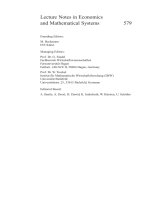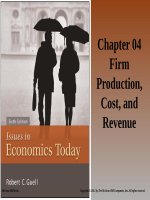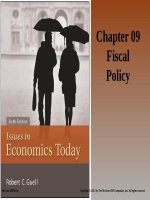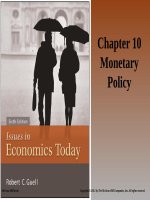Lecture Issues in economics today - Chapter 24
Bạn đang xem bản rút gọn của tài liệu. Xem và tải ngay bản đầy đủ của tài liệu tại đây (235.72 KB, 20 trang )
Chapter 24
The Economics of Crime
McGrawHill/Irwin
© 2002 The McGrawHill Companies, Inc., All Rights Reserved.
Chapter Outline
•
•
•
•
WHO COMMITS CRIME AND WHY
THE RATIONAL CRIMINAL MODEL
THE COSTS OF CRIME
OPTIMAL SPENDING ON CRIME
CONTROL
McGrawHill/Irwin
© 2002 The McGrawHill Companies, Inc., All Rights Reserved.
Who Commits Crime and Why
• Disproportionately to their percentage in
the population crime is committed by
– Men
– The young
– The poor
– The socially disadvantaged
McGrawHill/Irwin
© 2002 The McGrawHill Companies, Inc., All Rights Reserved.
Sources of Crime Statistics
• Police reports
– Potentially subject to police biases against
minorities.
• Victim accounts
– Not subject to bias because it is in the
interest of a victim to give an accurate
description of the perpetrator.
McGrawHill/Irwin
© 2002 The McGrawHill Companies, Inc., All Rights Reserved.
The Result
• Whether we look at crime rates from
police reports or from victim accounts
the result is the same:
– minorities commit more crime than would
be accounted for by their 24% of the
population.
McGrawHill/Irwin
© 2002 The McGrawHill Companies, Inc., All Rights Reserved.
The Rational Criminal Model
• Becker’s rational criminal model (RCM)
assumes that a criminal’s choice to commit a
crime is a rational one comparing the benefits
of the crime with the uncertain outcome of
success or jail.
• The model looks at crime like an investment:
take a risk, get a high expected return; play it
safe, get a low expected return.
McGrawHill/Irwin
© 2002 The McGrawHill Companies, Inc., All Rights Reserved.
Implications of the RCM
• People with high legally-derived income
are less likely to commit crime.
• The greater the punishment the less
likely the criminal is to commit crime.
• The more likely the criminal is to be
caught the less likely they are to commit
crime.
McGrawHill/Irwin
© 2002 The McGrawHill Companies, Inc., All Rights Reserved.
Evidence in favor of the RCM
• Less than half of the prison population
has a high school degree.
• 33% of criminals were not working
when they committed their crime.
• Crime rose during the 1980s as real
income for the poor was stagnant or
falling and fell during the 1990s when it
was rising.
McGrawHill/Irwin
© 2002 The McGrawHill Companies, Inc., All Rights Reserved.
Evidence against the RCM
• Crime rose during the 1960s when real
income for the poor was rising.
• Crime was much lower during the
1930s when incomes were quite low
because of the depression.
McGrawHill/Irwin
© 2002 The McGrawHill Companies, Inc., All Rights Reserved.
Challenges to the Basic
Assumptions of the RCM
• While property and drug crimes can be
seen through the expected “costbenefit” lens, others can not:
– e.g. rape, spousal abuse, assault, school
shootings.
– murder for hire is classic RCM but
generally murder is not for monetary gain.
McGrawHill/Irwin
© 2002 The McGrawHill Companies, Inc., All Rights Reserved.
Costs of Crime
• $93 billion is currently spent on the
criminal justice system (police, courts
and prisons)
• There are nearly 14 million crimes
– 1.8 million violent
– 12 million non-violent
– Approximately 14 million more are
unreported
McGrawHill/Irwin
© 2002 The McGrawHill Companies, Inc., All Rights Reserved.
How Much Does an Average
Crime Cost
• Types of costs
– Items taken or damaged
– Lost income of victims
– Psychological damage or “pain and suffering”
• Costs per crime estimates
– Ignoring Pain and Suffering ..$500
– Including Pain and Suffering..$2,000-$3,000
McGrawHill/Irwin
© 2002 The McGrawHill Companies, Inc., All Rights Reserved.
Pain and Suffering
Calculations
• How much is pain and suffering worth?
• Do you look at
– Costs of psychological care?
– Damage awards from jury trials?
• Can you calculate a dollar value of pain
and suffering
– to the spouse of a murder victim
– a rape victim.
McGrawHill/Irwin
© 2002 The McGrawHill Companies, Inc., All Rights Reserved.
How Much Crime Does an
Average Criminal Commit
• Estimates from criminologists vary from
a 12 to 180.
• Economists use a conservative 15 to 20
to estimate the usefulness of crime
control.
McGrawHill/Irwin
© 2002 The McGrawHill Companies, Inc., All Rights Reserved.
The Net Result on the Question
of How Much Crime Costs
• At 15 crimes per year and $500 per
crime each criminal commits $7,500
worth of crime each year he is not in
jail.
• At 20 crimes per year and $3,000 per
crime each criminal commits $60,000
worth of crime each year he is not in
jail.
McGrawHill/Irwin
© 2002 The McGrawHill Companies, Inc., All Rights Reserved.
Optimal Spending on Crime
Control
• While the “average” criminal may commit
$60,000 worth of crime and it costs only
$22,000 per year to keep them in prison, that
is not what an economist would use to make
the case.
• An economist would look at the benefit of
locking up one additional criminal and
compare that to the marginal cost of doing so.
This is called Marginal Analysis.
McGrawHill/Irwin
© 2002 The McGrawHill Companies, Inc., All Rights Reserved.
Are the Right People in Jail?
• More than half of the prison population
in many states is incarcerated for drug
crimes.
• Does it make sense to have a
nonviolent person in prison?
McGrawHill/Irwin
© 2002 The McGrawHill Companies, Inc., All Rights Reserved.
What Laws Should we
Rigorously Enforce
• The marginal benefit of arresting all
murderers or rapists is greater than the
marginal benefit of arresting all recreational
drug users and jaywalkers.
• The marginal cost of arresting only murders
and rapists is less than the marginal cost of
arresting all drug users and jaywalkers.
• Economists compare the marginal cost and
the marginal benefit of targeting particular
crimes.
McGrawHill/Irwin
© 2002 The McGrawHill Companies, Inc., All Rights Reserved.
Marginal Cost and Marginal
Benefit
Marginal Costs
Marginal Benefits
MC
MB
Murders, Rapists, Drug Dealers, Drug Users, Jaywalkers
McGrawHill/Irwin
© 2002 The McGrawHill Companies, Inc., All Rights Reserved.
What is the Optimal Sentence?
• Death Penalty vs. Life in Prison without
Parole
– Death Penalty Costs
• Present value of extra adjudication
• Dollar value of executing the innocent
– Life without Parole Costs
• Present value of housing costs
• Present value of medical costs for an aged inmate.
– Economists generally agree that in monetary
terms, the death penalty costs more than life in
prison.
• Length of Sentence
– As sentences get longer
McGrawHill/Irwin
• the marginal costs of adding another year to a sentence
grow (because of medical costs),
• the benefits decrease (because
the older you are the
© 2002 The McGrawHill Companies, Inc., All Rights Reserved.









